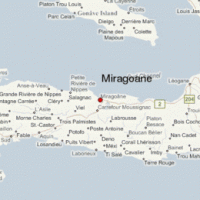Miragoane

Miragoâne rests on the northern coast of the western peninsula of Haiti. As part of the Nippes Department and its capital, it is a main port of second-hand imports from Miami. At the port, merchants purchase imports and vend them at Miragoâne street stalls.
The town was founded by English during the 17th century on the coast of a well-protected bay. The name Miragoâne comes from Miraguano, the name given by the Taíno people to the Étang de Miragoâne, the second largest lake of Haiti; the town is near the lake. The name of the city comes from the first Spanish Europeans who named it because of the presence of iguanas (iguana) that were there. During a civil war in 1883, the town was destroyed.
The history of Miragoâne port, among the largest natural ports of the globe, was as a gathering place for the Spanish when the island was called Hispaniola. Eventually the French chased them out.
The city lies on the north coast of the Tiburon Peninsula, along the Gonâve canal and in particular the Miragoâne Bay. One kilometer southeast is Lake Miragoâne, one of Haiti’s largest freshwater lakes.
Miragoâne, ringed by mountains, is protected by Ile Gonâve, which lies above it on an inlet of the Caribbean Sea. During its early history, gold was discovered and mined there.
Miragoâne had six communal sections (now four) and had three districts, two of which are now independent towns. Only the city is coastal, the rest of the commune, i.e. the districts and the communal sections are inland.
Economy: Today, Miragoâne, one of the main Haitian trading ports, ranks as the number three biggest port along the southern-eastern part of the Caribbean Sea. Shipments of manufactured goods from the United States pass through the Miragoâne docks. Haiti exports its coffee, its fruits and its wood by this same port. During the rule of Jean-Claude Duvalier, the port was shut down. Affected by its closing, the region’s economy suffered and unemployment is very high now as elsewhere on the region.
Port facilities were also used by Reynolds Metals Company of the United States, which specializes in aluminum and exports of bauxite from Haiti. This company left the Haitian territory leaving behind large infrastructure, including a deep-water port that replaced in 2010 the former civilian port of the town. The city is also endowed with tobacco crops.
The municipality has nine hotels, nine restaurants, a bank, three Caisses populaires and a marketing cooperative.
Agriculture and livestock, trade, and fishing are the main economic activities of the inhabitants of the commune. The majority of the inhabitants work in Port-au-Prince and La Gonâve.
Infrastructure: Miragoâne residents have managed to build its infrastructure in the areas of education and basic services. Cleanliness is important to them. Bi-weekly, about two dozen members of the community pick up trash clotting the streets of the city. Desiring to make the capital more attractive, the community is willing to toil under heat and humidity for many hours. They bring with them gardening tools to remake the streets and roads more traversable. The people of Miragoâne struggle to make their city a model of cleanliness and provide necessary services to the community.
Education The Ministry of the National Education for Youth and Sports is represented in the municipality by the departmental management of Nippes. Six Kindergarten, several primary schools including private and public, and 20 secondary schools were counted in the commune. There is a technical and professional school and several Literacy Centers.
Health The Ministry of Public Health and Population is represented in the commune by the sanitary Coordination of Nippes. There is a hospital, two health centers and nine clinics.
Utilities The city suffers from the obsolescence of its electrical installations as well as for the distribution of drinking water.
With respect to water resources, the municipality has seven rivers, eleven Springs, a pond and ten public fountains. Only the city of Miragoâne is electrified. The frequency of electrical power is 77 hours per week. The municipality also has a sanitation service.
After the devastating earthquake of January 2010, a new electricity grid was set up with the installation of individual meters to change the “energy-consuming” habits of the inhabitants.
Security At the administrative and judicial level, the municipality of Miragoâne has a police station and two peace courts. However, there is no prison, but a police room.
Religion Concerning religion, the municipality has twelve Catholic churches (including chapels), six Adventist churches, two churches of God, three halls of the Kingdom of the Witnesses of Jehovah and 17 other churches (3 churches of Jesus, 10 churches of Salvation Army and 4 Nazarene churches).
Communication The municipality has a postal service, three radio stations, and a television station.
Leisure As for leisure, the municipality has a library, a Theatre room, six night clubs, eight Gaguères and a public square. In Miragoâne , the following sports are practiced: football (soccer), basketball, judo and karate. In terms of cultural heritage, the town has a historical site and a cave.
Organizations The municipality of Miragoâne has two political parties, two Popular organizations and 17 NGOs.
L’église Saint-Jean-Baptiste, in neo-Gothic style, dates from the nineteenth century.

